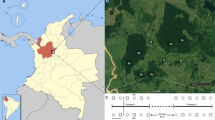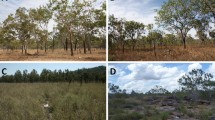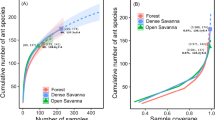Abstract
Habitat heterogeneity has a complex effect on ant species richness and community structure (both alpha- and beta-diversity). Savannahs and forests are thought to have distinct species assemblages, but studies comparing savannah–forest mosaics produced conflicting results, with savannah (the less complex ecosystem) poorer in species, equally rich, or richer than forest (the most complex habitat). We compared subterranean and above ground ant assemblages in savannah and forests of Lamto Reserve (Côte d’Ivoire) to examine how habitat heterogeneity and vertical stratification drive species composition and structure patterns. The Ants of the Leaf Litter (ALL) protocol and soil monolith were used to sample ants along 16 transects of 200 m in the three main habitats (gallery forest, forest islands, and savannah). In total, 138 species from 44 genera were collected. Forested habitats held assemblages that matched those found in savannah in terms of species density and richness; however, they differed in composition. Taxonomic structure varied among habitats, with Formicinae and Amblyoponinae prevailing in savannah, and Myrmicinae numerically dominant in forests. Ants were clearly vertically stratified. Subterranean assemblages had a less even distribution of occurrences among species as compared to above ground ones. The patterns observed agree with the heterogeneity-diversity theory relative to beta-diversity but not alpha-diversity, emphasizing the difficulty to generalize across continents about factors structuring ant assemblages. Our results support the need to conserve both forest and savannah to maintain biodiversity at landscape level in Côte d’Ivoire.








Similar content being viewed by others
References
Adjanohoun E (1964) Végétation des savanes et des rochers découverts en d’Ivoire centrale. Memoir ORSTOM 7, Paris, p 178
Agosti D, Alonso LE (2000) The ALL protocol. In: Agosti D, Majer JD, Alonso LE, Schultz TR (eds) ANTS: standard methods for measuring and monitoring biodiversity. Smithsonian Institution Press, Washington DC, pp 204–206
Andersen AN (1991) Sampling communities of ground-foraging ants: pitfall catches compared with quadrat counts in an Australian tropical savannah. Aust J Ecol 16:273–279
Andersen AN, Brault A (2010) Exploring a new biodiversity frontier: subterranean ants in northern Australia. Biodivers Conserv 19:2741–2750. doi:10.1007/s10531-010-9874-1
Andersen AN, van Ingen LT, Campos RI (2007) Constrasting rainforest and savanna ant faunas in monsoonal northern Australia: a rainforest patch in a tropical savanna landscape. Aust J Zool 55:363–369
Avenard JM (1969) Réflexions sur l’état de la recherche concernant les problèmes posés par le contact forêt-savane. Essai de mise au point et de la bibliographie. ORSTOM series Initiations et Documentations Techniques 14, Paris, p 149
Beale CM, van Rensberg S, Bond WJ, Coughenour M, Fynn R, Gaylard A, Grant R, Harris B, Jones T, Mduma S, Owen-Smith N, Sinclair ARE (2013) Ten lessons for the conservation of African savannah ecosystems. Biol Conserv 167:224–232. doi:10.1016/j.biocon.2013.08.025
Belshaw R, Bolton B (1994) A survey of the leaf litter ant fauna in Ghana, West Africa (Hymenoptera: Formicidae). J Hymenopt Res 3:5–10
Berghoff SM, Maschwitz U, Linsenmair KE (2003) Hypogaeic and epigaeic ant diversity on Borneo: evaluation of baited sieve buckets as a study method. Trop Zool 16:153–163. doi:10.1080/03946975.2003.10531192
Berman M, Andersen AN (2012) New Caledonia has a depauperate subterranean ant fauna, despite spectacular radiations above ground. Biodivers Conserv 21:2489–2497. doi:10.1007/s10531-012-0309-z
Bond WJ, Parr CL (2010) Beyond the forest edge: ecology, diversity and conservation of the grassy biomes. Biol Conserv 143:2395–2404. doi:10.1016/j.biocon.2009.12.012
Bonnet E, Van de Peer Y (2002) zt: a software tool for simple and partial Mantel tests. J Stat Softw 7:1–12
Bonvallot J, Dugerdil M, Duviard D (1970) Recherches écologiques dans la savane de Lamto (Côte d’Ivoire): répartition de la végétation dans la savane pré-forestière. La Terre et la Vie 24:3–21
Brandão CRF, Feitosa RM, Schmidt FA, Solar RRC (2008) Rediscovery of the putatively extinct ant species Simopelta minima (Brandão) (Hymenoptera, Formicidae), with a discussion on rarity and conservation status of ant species. Rev Bras Entomol 52:480–483
Brühl CA, Gunsalam G, Linsenmair KE (1998) Stratification of ants (Hymenoptera, Formicidae) in a primary rain forest in Sabah, Borneo. J Trop Ecol 14:285–297
Calcaterra LA, Cuezzo F, Cabrera SM, Briano JA (2010) Ground ant diversity (Hymenoptera: Formicidae) in the Iberá Nature Reserve, the largest wetland of Argentina. Ann Entomol Soc Am 103:71–83
Campos RI, Lopes CT, Magalhães WCS, Vasconcelos HL (2008) Estratificação vertical de formigas em Cerrado strictu sensu no Parque Estadual da Serra de Caldas Novas, Goiás, Brasil. Iheringia Sér Zool 98:311–316
Campos RI, Vasconcelos HL, Andersen AN, Frizzo TLM, Spena KC (2011) Multi-scale ant diversity in savanna woodlands: an intercontinental comparison. Austral Ecol 36:983–992. doi:10.1111/j.1442-9993.2011.02255.x
Clarke K (1990) Comparisons of dominance curves. J Exp Mar Biol Ecol 138:143–157
Clarke K and Gorley R (2006) Primer v6: User manual/tutorial.Plymouth: Primer-E
Colwell RK (2013) EstimateS: Statistical estimation of species richness and shared species from samples. Version 9.1. User’s Guide and application published at: http://purl.oclc.org/estimates
Colwell RK, Chao A, Gotelli NJ, Lin SY, Mao CX, Chazdon RL, Longino JT (2012) Models and estimators linking individual-based and sample-based rarefaction, extrapolation and comparison of assemblages. J Plant Ecol 5(1):3–21. doi:10.1093/jpe/rtr044
Delabie JHC, Fowler HG (1995) Soil and litter cryptic ant assemblages in Bahian cocoa plantations. Pedobiologia 39:423–433
Devineau J-L (1975) Etude quantitative des forêts galeries de Lamto (Moyenne Côte d’Ivoire). Thèse de Doctorat 3è cycle, Université Paris 6, p 190
Devineau J-L (1984) Structure dynamique de quelques forêts tropicales de l’Ouest africain (Côte d’Ivoire). Thèse de Doctorat d’Etat de l’Université Pierre et Marie Curie p 294
Dosso K, Yéo K, Konaté S and Linsenmair KE (2012) Importance of protected areas for biodiversity conservation in central Côte d’Ivoire: Comparison of termite assemblages between two neighbouring areas under differing levels of disturbance. J Insect Sci 12: 131. Available online 12:131. Available online: http://www.insectscience.org/12.131
Dosso K, Deligne J, Yéo K, Konaté S, Linsenmair KE (2013) Changes in the termite assemblage across a sequence of land-use systems in the rural area around Lamto Reserve in central Côte d’Ivoire. J Insect Conserv 17:1047–1057. doi:10.1007/s10841-013-9588-2
Dufrêne M, Legendre P (1997) Species assemblages and indicator species: the need for a flexible asymmetrical approach. Ecol Monogr 67:345–366
Dunn RR, Guénard B, Weiser MD and Sanders NJ (2010). Geographic gradients. In Lach L, Parr CL, Abbott KL Ant Ecology. Oxford University Press, pp 38–58
Fahr J, Kalko EKV (2011) Biome transitions as centres of diversity: habitat heterogeneity and diversity patterns of West African bat assemblages across spatial scales. Ecography 34:177–195. doi:10.1111/j.1600-0587.2010.05510.x
Fernandes IO, Souza JLP, Fernández FC, Delabie JHC, Schultz TR (2015) A new species of Simopelta (Hymenoptera: Formicidae: Ponerinae) from Brazil and Costa Rica. Zootaxa 3956(2):295–300. doi:10.11646/zootaxa.3956.2.10
Fischer F (2004) Status of the Comoé National Park, Côte d’Ivoire, and the effects of war. Parks 14:17–23
Fisher BL (1997) A comparison of ant assemblages (Hymenoptera: Formicidae) on serpentine and non serpentine soils in northern California. Insect soc 44:23–33
Fisher BL (1999) Improving inventory efficiency: A case study of leaf-litter ant diversity in Madagascar. Ecol Appl 9:714–731
Fisher BL, Robertson HG (2002) Comparison and origin of forest and grassland ant assemblages in the High plateau of Madagascar (Hymenoptera: Formicidae). Biotropica 34:155–167
Fisher BL, Malsh AKF, Gadagkar R, Delabie JHC, Vasconcelos HL, Majer JD (2000) Applying the ALL protocol. In: Agosti D, Majer JD, Alonso LE, Schultz TR (eds) ANTS: standard methods for measuring and monitoring biodiversity. Smithsonian Institution Press, Washington DC, pp 207–214
Fowler HG, Delabie JHC, Moutinho PRS (2000) Hypogaeic and epigaeic ant (Hymenoptera: Formicidae) assemblages of Atlantic costal rainforest and dry mature and secondary Amazon forest in Brazil: continuums or communities. Tropical Ecology 41:73–80
Gauthier L (1990) Carte du recouvrement ligneux de Lamto. Echelle: 1/10000. Conservatoire et Jardin Botanique de Genève, Genève
Gonedelé Bi S, Koné I, Bitty AE, Béné Koffi JC, Akpatou B, Zinner D (2012) Distribution and conservation status of catarrhine primates in Côte d’Ivoire (West Africa). Folia Primatol 83:11–23. doi:10.1159/000338752
Guillaumet JL (1967) Recherches sur la végétation et la flore de la région du Bas-Cavally (Côte d’Ivoire). Memoir ORSTOM 20, Paris, p 240
Hardy O (2005) BiodivR 1.0. A program to compute statistically unbiases indices of species diversity within samples and species similarity between samples using rarefaction principles. Université Libre de Bruxelles
Hashimoto Y, Morimoto Y, Widodo ES, Mohamed M (2006) Vertical distribution pattern of ants in a Bornean tropical rainforest (Hymenoptera: Formicidae). Sociobiology 47:697–710
Itino T, Yamane S (1995) The vertical distribution of ants on canopy trees in a Bornean lowland rain forest. Tropics 4:277–281
Jacquemin J, Drouet T, Delsinne T, Roisin Y, Leponce M (2012) Soil properties only weakly affect subterranean ant distribution at small spatial scales. Appl soil Ecol 62:163–169. doi:10.1016/j.apsoil.2012.08.008
Kaspari M, O’Donnel S, Kercher JR (2000) Energy, density, and constraints to species richness: ant assemblages along a productivity gradient. Am Nat 155:280–293
Kaspari M, Yuan M, Alonso L (2003) Spatial grain and gradients of ant species richness. Am Nat 161:459–477
Kaspari M, Ward PS, Yuan M (2004) Energy gradients and the geographic distribution of local ant diversity. Oecologia 140:407–413
Kone M, Konate S, Yeo K, Kouassi PK, Linsenmair KE (2012) Changes in ant communities along an age gradient of cocoa cultivation in the Oumé region, central Côte d’Ivoire. Entomol Sci 15:324–339. doi:10.1111/j.1479-8298.2012.00520.x
Lamotte M and Tireford JL (1988) Le climat de la savane de Lamto (Côte d’Ivoire) et sa place dans les climats de l’Ouest africain. Travaux de Recherche de Lamto vol. 8, p 146
Lassau SA, Hochuli DF (2004) Effects of habitat complexity on ant assemblages. Ecography 27:157–164
Lévieux J (1971) Données écologiques et biologiques sur le peuplement en fourmis terricoles d’une savane préforestière de Côte d’Ivoire. Thèse de Doctorat de la Faculté des Sciences de Paris, p 288
Lévieux J (1983) Soil fauna of tropical savannahs: 4 The ants. In: Bourlière F (ed) Tropical savannahs pp 525–540. Elsevier, Amsterdam
Longino JT, Coddington J, Colwell RK (2002) The ant fauna of a tropical rain forest: estimating species richness, three different ways. Ecology 83:689–702
Lynch JF, Johnson AK, Balinsky EC (1988) Spatial and temporal variation in the abundance and diversity of ants (Hymenoptera: Formicidae) in the soil and litter layers of a Maryland forest. Am Midl Nat 119:31–44
Maguran AE (2004) Measuring biological diversity. Blackwell Publishing, Oxford, p 256
Mangenot G (1955) Etude sur les forêts des plaines et plateaux de Côte d’Ivoire. Etudes Eburnéennes 6:5–61
Maravalhas J, Vasconcelos HL (2014) Revisiting the pyrodiversity–biodiversity hypothesis: long-term fire regimes and the structure of ant communities in a Neotropical savanna hotspot. J Appl Ecol 51:1661–1668
McCoy ED, Bell SS (1991) Habitat structure: the evolution and diversification of a complex topic. In: McCoy ED, Bell SS and Mushinsky HR (eds) Habitat structure: the physical arrangements of objects in space, Chapman & Hall, pp 3–27
McCune B and Mefford MJ (1999) PC-ORD – Multivariate Analysis of Ecological Data, Version 5.0. MjM Software, Gleneden Beach, Oregon, USA
McGeoch MA, van Rensburg BJ, Botes A (2002) The verification and application of bioindicators: a case study of dung beetles in a savannah ecosystem. J Appl Ecol 39:661–672
Menaut JC (1971) Etude de quelques peuplements ligneux d’une savane guinéenne de Côte d’Ivoire. Thèse de doctorat 3ème cycle (Faculté des sciences de Paris), 141 pp
Menaut JC, Cesar J (1979) Structure and primary productivity of Lamto savannas, Ivory Coast. Ecology 60:1197–1210
Neves FS, Queiroz-Dantas KS, da Rocha WD, Delabie JHC (2013) Ants of three adjacent habitats of a transition region between the Cerrado and Caatinga biomes: the effects of heterogeneity and variation in canopy cover. Neotrop Entomol 42:258–268. doi:10.1007/s13744-013-0123-7
Pacheco R, Vasconcelos HL (2012a) Habitat diversity enhances ant diversity in a naturally heterogeneous Brazilian landscape. Biodivers Conserv 21:797–809. doi:10.1007/s10531-011-0221-y
Pacheco R, Vasconcelos HL (2012b) Subterranean pitfall traps: is it worth including them in your ant sampling protocol? Psyche. doi:10.1155/2012/870794
Parr CL, Sinclair BJ, Andersen AN, Gaston KJ, Chown SL (2005) Constraint and competition in assemblages: a cross-continental and modeling approach for ants. Am Nat 165:481–494
Parr CL, Lehmann CER, Bond WJ, Hoffmann WA, Andersen AN (2014) Tropical grassy biomes: misunderstood, neglected, and under threat. Trends Ecol Evol 29:205–213
Peltre P (1977) Le « V Baoulé » (Côte d’Ivoire centrale). Héritage géomorphologique et paléoclimatique dans le tracé du contact forêt-savane. Travaux et Document de l’ORSTOM N°80, p 197
Philpott SM, Perfecto I, Armbrecht I, Parr CL (2010) Ant diversity and function in disturbed and changing habitats. In: Lach L, Parr C, Abbott K (eds) Ant ecology. Oxford University Press, Oxford, pp 137–156
Portère R (1950) Problèmes sur la végétation de la basse Côte d’Ivoire. Bulletin de la Société Botanique de France 97:153–156
Rabeling C, Brown JM, Verhaagh M (2008) Newly discovered sister lineage sheds light on early ant evolution. P Natl Acad Sci USA 105:14913–14917
Ryder Wilkie KT, Mertl AL, Traniello JFA (2007) Biodiversity below ground: probing the subterranean ant fauna of Amazonia. Naturwissenschaften 94:725–731. doi:10.1007/s00114-007-0250-2
Schmidt FA, Diehl E (2008) What is the effect of soil use on ant communities? Neotrop Entomol 37:381–388
Schmidt FA, Solar RRC (2010) Hypogaeic pitfall traps: methodological advances and remarks to improve the sampling of a hidden ant fauna. Insect Soc 57:261–266. doi:10.1007/s00040-010-0078-1
Schmidt FA, Feitosa RM, de Moraes Rezende F, Silva de Jesus R (2013) News on the enigmatic ant genus Anillidris (Hymenoptera: Formicidae: Dolichoderinae: Leptomyrmecini). Myrmecological News 19:25–30
Silva RR, Silvestre R (2004) Riqueza da fauna de formigas (Hymenoptera: Formicidae) que habita as camadas superficiais do solo em Seara, Santa Catarina. Papéis Avulsos Zoologia 44:1–11
Spichiger R (1977) Contribution à l’étude du contact entre flore sèche et humide sur les lisières des formations forestières humides sémi-décidues du V Baoulé et de son extension nord-ouest. Bulletin de liaison des chercheurs de Lamto, numéro spécial fascicule 1, Paris, p 261
Stein A, Kreft H (2015) Terminology and quantification of environmental heterogeneity in species-richness research. Biol Rev 90:815–836. doi:10.1111/brv.12135
Stein A, Gerstner K, Kreft H (2014) Environmental heterogeneity as a universal driver of species richness across taxa, biomes and spatial scales. Ecol Lett 17:866–880. doi:10.1111/ele.12277
Tews J, Brose U, Grimm V, Tielbörger K, Wichmann MC, Schwager M, Jeltsch F (2004) Animal species diversity driven by habitat heterogeneity/diversity: the importance of keystone structures. J Biogeogr 31:79–92
van Ingen LT, Campos RI, Andersen AN (2008) Ant community structure along an extended rain forest–savanna gradient in tropical Australia. J Trop Ecol 24:445–455. doi:10.1017/S0266467408005166
Vasconcelos HL, Vilhena JMS (2006) Species turnover and vertical partitioning of ant assemblages in the Brazilian Amazon: a comparison of forests and savannas. Biotropica 38:100–106. doi:10.1111/j.1744-7429.2006.00113.x
Veldman JW, Buisson E, Durigan G, Fernandes GW, Le Stradic S, Mahy G, Negreiros D, Overbeck GE, Veldman RG, Zaloumis NP, Putz FE, Bond WJ (2015) Toward an old-growth concept for grasslands, savannas, and woodlands. Front Ecol Environ 13:154–162. doi:10.1890/140270
Verhaag M, Rościszewski K (1994) Ants (Hymenoptera, Formicidae) of forest and savanna in the Biosphere Reserve Beni, Bolivia. Andrias 13:199–214
Wetterer J (2010) Worldwide spread of the pharaoh ant, Monomorium pharaonis (Hymenoptera: Formicidae). Myrmecological News 13:115–129
Wetterer J (2012) Worldwide spread of the African big-headed ant, Pheidole megacephala (Hymenoptera: Formicidae). Myrmecological News 17:51–62
Yanoviak SP, Kaspari M (2000) Community structure and the habitat templet: ants in the tropical forest canopy and litter. Oikos 89:259–266
Acknowledgements
This Project was conducted at Lamto Ecology Station in Côte d’Ivoire and the authors are grateful to Kouakou Firmin and Kouassi Kouassi (Apo) for their help during field work. The authors thank Brian L. Fisher and anonymous referees for their constructive comments on previous versions of the manuscript. The authors are grateful to Barry Bolton, Stephan Cover, and Gary Alpert as well as Janine Casevitz-Weulersse for their help during ant identification at Natural History Museum (London), Museum of Comparative Zoology (Cambridge), and Muséum National d’Histoire Naturelle (Paris), respectively. This work was financed by the French government (co-tutelle de thèse 2002-2004), Conservation International (Rapid Assessment Programs), and the Ernst Mayr Grant (Harvard University). Thibaut Delsinne thanks the Secretary of Higher Education, Science, Technology and Innovation (SENESCYT) of the Government of Ecuador for financial support (Prometeo Grant) during the statistical analyses and writing of this paper.
Author information
Authors and Affiliations
Corresponding author
Electronic supplementary material
Below is the link to the electronic supplementary material.
Rights and permissions
About this article
Cite this article
Yeo, K., Delsinne, T., Konate, S. et al. Diversity and distribution of ant assemblages above and below ground in a West African forest–savannah mosaic (Lamto, Côte d’Ivoire). Insect. Soc. 64, 155–168 (2017). https://doi.org/10.1007/s00040-016-0527-6
Received:
Revised:
Accepted:
Published:
Issue Date:
DOI: https://doi.org/10.1007/s00040-016-0527-6




